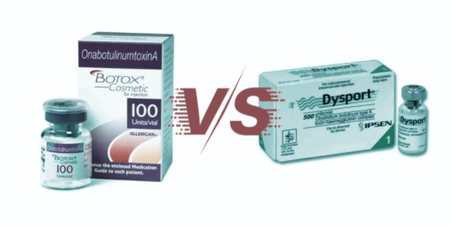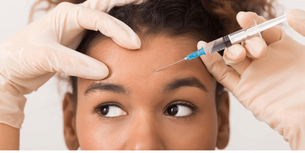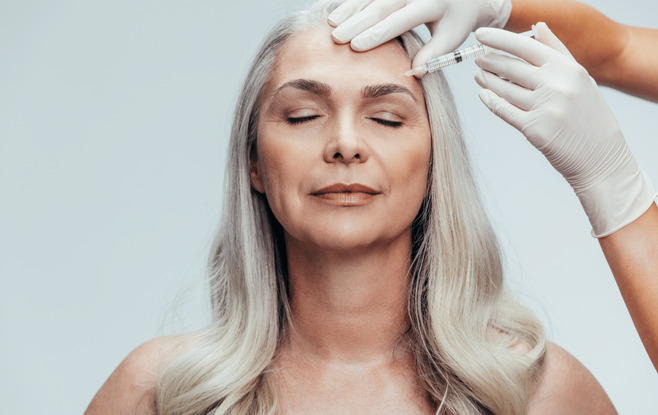
Wrinkles are a natural part of the ageing process. Our skin loses suppleness over time as a result of decreased collagen, elastin, smoking, and increasing sun exposure. Facial emotions such as frowning, squinting, and even smiling can accentuate wrinkles. These wrinkles can appear sooner than we expect. As the expression goes, our thoughts have more wrinkles than our looks as we get older. We want to appear as youthful as we are! We can now achieve all of this and more using injectables like Botox and Dysport. We'll discuss injectables and dissect the Botox vs. Dysport argument here.
All About The Injectables
Taking care of our skin, drinking plenty of water, and using cosmetics aren't always enough to get wrinkle-free, regenerated skin. Injectables are a great non-surgical option for smoothing out wrinkles. Some can even add volume to a portion of our face. Injectables are chemical substances that are ‘injected' into certain parts of our faces. These injectables can help shape portions of the body and lessen the appearance of wrinkles. Injectables were once frowned upon, but since 2015, about 2.5 million injectable operations have been performed annually.
Neuromodulators and soft-tissue fillers are the two types of injectables. Neuromodulators work by decreasing the lines that result from facial movement. Soft-tissue fillers aim to restore volume to areas including the cheeks, lips, chin, and forehead that have lost volume with age. Botox and Dysport, both neuromodulators, have advantages in terms of preventing wrinkles for months at a time.
What exactly is Botox?
Botox is a neuromodulator derived from the Clostridium botulinum bacterium. Botox, also known as Botulinum Type A, can diminish or eliminate fine lines and wrinkles when taken in small dosages. The injectable works by preventing nerve signals from reaching the brain from muscles in the face. When utilised improperly, the toxin can be extremely harmful and cause botulism symptoms. Botox is safe and effective when administered by a board-certified dermatologist or plastic surgeon.
Botox paralyses the muscles in the face, preventing them from contracting as freely as before. This absence of mobility smoothes the skin and lowers the appearance of wrinkles dramatically. Botox was the first FDA-approved Botulinum Type A neuromodulator, launching in 1989 and receiving aesthetic clearance in 2002. It has since become the industry's leading injectables brand. Botox can also be used to treat a variety of medical issues.
What is Dysport, and how does it work?

Dysport (sometimes misspelled as sdysport) is a term used to describe a condition in which other companies have introduced injectables to aid with wrinkles since the introduction of Botox. Dysport, which was introduced shortly after Botox and now serves over 60 nations worldwide, was dubbed the European alternative to Botox. Dysport was licenced for use in the United States by the FDA in 2009. It has since been demonstrated to be an effective, non-invasive wrinkle and fine line therapy. Botox and Dysport were first approved for medical usage before being approved for cosmetic use.
Botulinum Type A, like Botox, is the active ingredient in Dysport. Dysport paralyses the nerves around the injection location once administered. This reduces muscle action, allowing the area to relax and the skin to smooth out. Dysport, on the other hand, is designed to treat moderate to severe forehead lines and glabellar lines, also known as frown lines or 11 lines. Both products should be available to your board-certified dermatologist, and he or she should be able to utilise them in different areas of your face.
What's the difference between Botox and Dysport?
At first look, the differences between Botox and Dysport appear to be minor. Both have the same active component (Botulinum Type A) and can help with wrinkle reduction. However, there are a few major differences that will influence your dermatologist's decision.
The amount of concentration in each product is the most significant difference. With a nearly 3 to 1 split, Dysport is more diluted than Botox. Your doctor may require more of it to fill one area than another, depending on where the injection is placed. Naturally, it's tempting to assume that Dysport will be significantly more expensive than Botox, but this is not the case. Botox is substantially more expensive per unit. Because the quantity of units is higher than Botox, the price per treatment will be same.
Dysport's molecular behaviour and diffusion are also distinct. With just a few injections, this makeup distributes quickly, especially across a greater surface area. As a result, the distinctions boil down to how each injectable is administered by your doctor. For specific locations, an experienced doctor will employ both:
- Lip lines, Crow's feet, and other fine creases can all benefit from Botox. It is slow-moving and has a high concentration, making it ideal for these compact spaces.
- Larger surface regions, such as the forehead and 11 lines, will benefit from Dysport. It's a quick-acting substance that spreads swiftly and uniformly.
You can safely use both for a similar price due to the difference in dilution.
Who is a good candidate, Botox or Dysport?

Botox and Dysport have both been authorised by the FDA. Adults between the ages of 35 and 65, according to most doctors, are the best prospects. Other considerations include:
- You should have moderate to severe face creases that haven't reacted favourably to dermatologist-recommended skin care.
- Your wrinkles should be around the lips, cheeks, eyes, chin, and forehead, which both Dysport and Botox can help with.
- You should be in pretty good health and free of any skin problems.
You should avoid the procedure if you're pregnant, breastfeeding, have skin allergies, or have a known Botulinum Type A allergy. Inform your doctor if you have any serious illnesses, disorders, or infections that could be hazardous.
Is there any variation in the procedures?
Both Dysport and Botox are administered in the same way. Your journey with injectables begins with a consultation with your dermatologist. The dermatologist examines your medical history, evaluates the current wrinkles on your face, and devises a treatment plan. In certain cases, the treatment approach includes both Dysport and Botox injections in the same session.
Botox and Dysport are non-invasive treatments that can be completed in as little as 30 minutes. Patients frequently receive their injection during their lunch break. Injectables have a faster recovery time and a higher success rate than invasive procedures.
Your doctor will mark the injection locations and numb the area using a topical anaesthetic. The Botox or Dysport will next be injected into the right areas by your doctor. Dysport injections can go deeper than Botox injections in some cases. The longer shot aids in covering larger treatment regions. You can go after inspecting your skin to make sure everything is fine. Your doctor will advise you on some basic do's and don'ts, such as:
- You must abstain from consuming alcohol for at least 48 hours.
- To avoid spreading the neuromodulator to other parts of your face, don't massage your face or injection locations.
- For at least 4 hours, refrain from exercising or engaging in intense activity.
- For at least 24 hours, stay out of direct sunlight.
- After that, do not lay down for 3 hours.
You'll see changes in your wrinkles and overall appearance during the next few days.
Is there any variation in effectiveness?
Both injectables have a high success rate when it comes to decreasing wrinkles. After just 30 days, 88 percent of patients in a 2019 research were extremely delighted with the results. Dysport lasts 3 to 4 months and requires follow-up treatments to maintain the fantastic results.
Botox is a safe and effective therapy that can last up to 4 months, while it may last up to 6 months depending on the injectable's location. Botox tends to remain much longer in tiny areas like the eyes and lips. The neuromodulator will break down into basic proteins that the body will absorb over time. After that, you'll notice some mobility in your muscles (but less wrinkles), which is a good sign that it's time to book your next appointment.
What about the negative consequences?
Both include Botulinum Toxin Type A, which means they could have the same negative effects. Keep in mind that each medical or cosmetic procedure carries some risk. Pain and swelling at the injection location, headache, ptosis (droopy eyelid), and dryness are all common side effects (if the injection is near the eyes). Muscle weakness, swallowing difficulties, and breathing problems are among the more serious side effects. If your treatments are administered by a licenced practitioner, side effects are unlikely.
Can Botox and Dysport be used in conjunction with other treatments?
Patients frequently inquire about alternate therapies in addition to Botox or Dysport. For example, you can get an injectable filler to plump up your skin and add volume where it's needed. Juvederm and Restylane are fillers that include hyaluronic acid, a natural chemical found in the skin. When combined with Botox or Dysport, a “liquid facelift” can be achieved. Liquid facelifts are becoming increasingly popular as an alternative to a major surgery.
Some patients may inquire about further procedures such as lasers, chemical peels, hydrafacials, and more. It's understandable that these individuals desire the greatest care possible as soon as feasible. Each procedure, however, is done on a case-by-case basis. Your dermatologist will proceed with caution, ensuring that your Botox or Dysport treatments are completed first. If everything goes well, you can return for a second treatment to address a different issue area at a later date.
Conclusion: Recognize the distinctions
In the Botox versus Dysport discussion, you'll discover that comparing the two injectables is quite tough. Both Dysport and Botox are helpful at reducing wrinkles and fine lines in moderate to severe cases.
The formulations of both injectables are the most significant difference. When compared to Botox, Dysport is significantly more diluted and spreads much faster. This makes it ideal for places with a bigger surface area, such as the forehead. Botox is far more powerful than fillers, making it ideal for small areas and stubborn creases like Crow's feet. That means the most significant variation is determined by the amount of injectable utilised and the time it takes to work.
It also comes down to how the injection is used by the expert. A dermatologist who is board-certified and has deep understanding of all things injectable will choose the ideal one for you.
